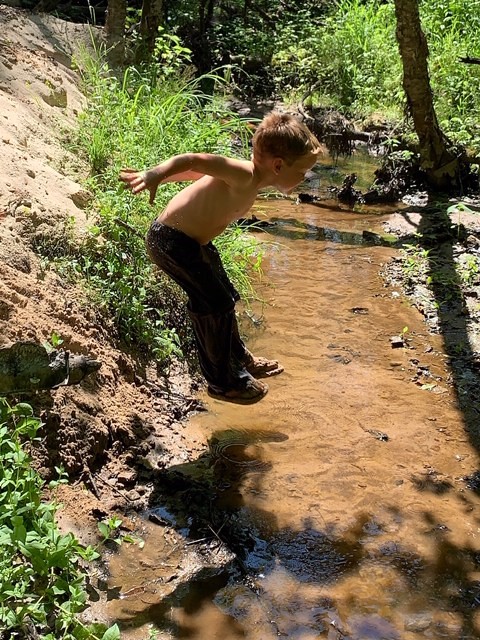Guest post by Julie Hoel, KVR Instructor and Grandparent Extraordinaire
No one whined more about the cancelling of KVR Summer Camps than I did. Just ask our camp director! I was the lone voice crying FOR the wilderness. It’s an OUTSIDE activity! Outside can be safe! Pleeease! My four-year-old grandkids were signed up for their first KinderCamp. We had all been looking forward to their time at KVR and Nana and Poppa time at our house. Their working-from-home parents had been looking forward to a break. We couldn’t let them down, so the cousins came anyway and Camp Covid was born.
There is plenty for them to do here…pond to swim in, trampoline, tree swing in a huge oak, a play set fort and my toy room. (Other retirees use their spare bedroom for a sewing room, an art studio or an office. Mine is a toy room filled with three generations of vintage family playthings and classroom toys from my mom’s first grade room and my kindergarten.) Our tendency would have been to hang out here, but I took my own advice to my Forest Friends session parents, and we headed to the woods anyway! Each morning we packed up for a new adventure. I ignored certain four year-old behaviors just to get them in the car and on our way. Don’t want to wear your long socks? No problem, I’ll just put them in my backpack. Still hungry? I have a car snack ready. Can’t find your water bottle? I’ll share mine.
Our first adventure was to the Ice Cave Trail at Wildcat State Park. In a moment of unplanned genius, I bought them each a pair of rubbery garden gloves for climbing and other muddy encounters. These came in handy right away as they scampered up the rocks by the waterfall. Letting them lead the way was also important. You really can’t get lost, and it put them in charge. They stopped and threw sticks when they felt like it. They followed the “beautiful butterflies” that caught their eyes. We splashed in the little creek. I pulled some plastic food containers out of my backpack and turned them into boats. I took a little video of this exploration. My grandson says, “Nana, do you have any other toys?” I don’t remember saying this, but I hear my response, “I thought this would be enough.” Turns out, it was more than enough.
Day Two destination was KVR. I was hoping to play at the stepping-stones on the Visitor Center Trail, but they were underwater. We headed to the climbing trees in the flood plain, but they were overgrown without the usual trampling by school groups. The cave by the river didn’t excite them. But finally the magic of the pine plantation caught their fancy. They explored all the shelters that kids have made there. I was shocked to hear that they did NOT know the story of the Three Little Pigs. Explaining the tale led to a spirited game with Poppa huffing and puffing and the little piggies dashing from one shelter to another oinking all the way. They could have played this for hours.
Day Three was at the Valley of the Elves. Something about that little stream inspires nakedness. Every time I take a group of Forest Friends there, someone ends up removing their clothes one soggy piece at a time. The embarrassed parent asks the group if everyone is okay with it and the fun continues. This day it was my grandson ripping off his shirt in the summer sun. They went upstream and discovered a small sandy bank. They proceeded to climb up and jump into the water making up songs as they went again and again. The trip back up to the rock shelter required cooperation and determination, but it was all worth it.
I could continue explaining each adventure, but I think you see the pattern. Ignore any resistance and get to the car. Get to some place wild. Follow their lead. Nature did the rest of the unfolding.The boy who is go-go-go and sports-sports-more sports settled down a little in the woods. On one hike he was just sitting in the brush up on a little hill. I asked him what he was doing. “I’m a deer.” The girl that loves beautiful sparkly dresses and won’t touch a cobweb ended the week proclaiming, “Dragon flies are my friends!” Most of all, it was magical for us watching them.
In the end, it felt like it might have been even better than KVR camp because they had our undivided attention in a class of just two. So, thanks, Covid, for that.


























